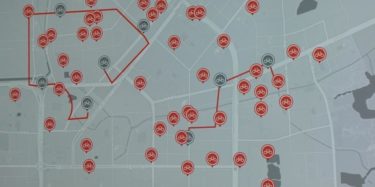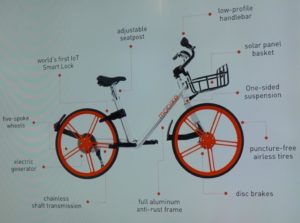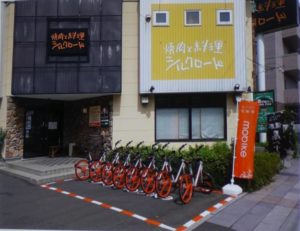Bike Sharing – and What Media Companies Can Learn from Chinese Startups
Gastbeitrag von Knut Nicholas Krause (CEO von knk Business Software)
New trends come from China
Shanghai, 06/13/2018. It is a phenomenon how fast mobike is growing. Founded in early 2015, three years later it is a multinational group of companies with 200million registered users, who perform 30 million bike rides per DAY (equivalent to about 900M unique visitors per month, who are all creating interactions!).
Initially inspired by the idea to bring the “bike age” back to China in order to reduce the smog created from the vast car traffic in Chinas metropolian cities, the founder Mrs. Weiwei Hu did not stop at China’s borders, but instantly expanded into other countries and now covers 200 cities on all continents, with Washington D.C., San Diego and Dallas being the most prominent cities in North America and London, Paris and Berlin in Europe.
Altough there are many competitors, mobike is incredibly successful. The inventor of bike sharing as such (“first generation”) is said to be a community in Amsterdam, in 1965 – which failed, because the bikes were quickly lost or heavily damaged. For 30years, the idea was dead. But in 1995 the city of Copenhagen in Denmark tried it again, this time with coins, which served as deposit (“2d generation”). Vandalism and Theft was still a huge issue, but the idea revived. The “3d generation” was introduced in 1996 in Rennes (France), where the user had to return the bike to a specific docking-station. In 2000, the state-owned German railway company Deutsche Bahn provided bike sharing on all their major railway stations which could be rented via an App and which were unlocked by SMS – that’s the “4th generation”.
mobike copied this idea (although they claim to be the first), but they executed much better on it: While Deutsche Bahn believed Bike Sharing is a mere service to their customers (kind of an additional cost factor) mobike understood the real market potential, improved the user experience even further and executed the idea on a global scale:
Function and Design reduces Operation Costs
mobike’s bikes are iconic. They don’t only look different by their orange-coloured, five-spoke car-like wheels, but the whole bike is re-engineered in order to optimally support it’s purpose and in order to reduce maintenance costs to the minimum. The core element of the bike is the lock though. The lock includes a SIM-card and a GPS-location device together with a battery, which is charged by a dynamo integrated into the front wheel or by a solar panel. The bike sends it’s position to mobike’s central computer and mobike’s app will show you all the available bikes in your area. When you pick one, you scan a code on the bike with the app and the lock will open up. Now the bike is your’s for up to a maximum of two hours. You pay a deposit in advance (which includes insurances, too) and you will be charged by the time or by a monthly flat fee.
While the first version of the bike was very heavy, the most current version (V.04) is light and comfortable. It now has gears, a shopping basket and a liftable seat, which fits as well North-American/European leg lenghts. The rest of the configuration depends on local traffic law requirements. While the first version had a specifically invented, chain-less traction system (in order to reduce maintenance issues), the newest version has a chain again: The lesson had to be learnt, that even though the traction system wore down slower compaired to chains, it still needed maintenance every now and then – and this maintenance was significantly more complex and overall too difficult for the maintenance staff. In addition, the bike driver needed more strength to drive the bike.
The founders of mobike spend the whole year 2015 on prototyping this and on finding cooperation partners, manufacturers and financing partners. In spring 2016, they went public. Within two more years, more than 9 Million bikes are already produced and distributed all over the world. Whilst the first bikes must have been expensive with all the specific engineering, the current production costs are expected to be very low. The rental price varies by the economic wealth of the area, where you rent them (your app serves as a global account). In the US, it is about $1 for a 30-minute ride. In Chengdu (China), the daily use of mobikes already exceeds the number of people using the (efficient) metro system!
Function and Design does the trick for the Marketing, too.
Altogether, a mobike stands out from the crowd at the first glance, which helps a lot to reduce marketing costs. Basically, when entering a new city, mobike does nothing but talking to the government asking for the local laws, license requirements and approvals, and – after having fullfilled all requirements quickly – the typically post some pictures with the local government and then distribute the bikes into the streets, close to bus and metro stations. This typically instantly create buzz, which is “auto-increasing” – the more people share the news, the better.
Piles of Bikes in Crowded Cities
As there are so many competitors in the bike sharing market, quite some cities in China and Europe already have a problem with masses of bikes using the common space on the sidewalks and blocking the streets. In Europe, urban administrations already discuss putting extra taxes on bike sharing businesses for using the municipal properties. Whilst the original idea of the “4th Generation” bike sharing was to get rid of the docking stations, and to allow the user to leave the bike at the end of the tour wherever he or she wants to, this creates issues with the municipal administrations now. As a mobike user is already scored today (e.g. the next user of the bike will rate, if he found the bike in good state), mobike now wants to teach their users “good behaviour” by introducing an incentivating system: Who returns his bike to marked bike-parking areas (checked by geo-location), will receive a sort of credit points – allowing free bike rides (and alike) later. mobike is looking for cooperation partners, who want to provide such parking spaces in return for a rent and/or marketing exposure.
Crowd Community Effects:
As in most committed communities, the mobike community developed own behaviours, too: E.g. there is the “Singapore bike patrol”, who spend their leisure time with maintenance and repair of mobikes; in China there are the “bike hunters“, who spot hidden/lost bikes and bringthem back into circulation; and in Asia and even in the UK there are couples, who perform their marriage on mobikes…
Ideas for Media Companies
But now: What is in for a media company? Two ideas, how to use the mobike hype as a media company:
– First for B2B or scientific publishers: mobike receives huge amounts of data – 40 terrabytes per day – from their bikes. Occasionally, on city management’s request of city mobike uses this data already to give advice to the town administration, where to build new bike tracks etc. But mainly, the data is used to improve the operation – to distribute more bikes into the right places and to send out bike mainentance teams or to get displaced bikes back into the city hubs. But you could licence the data and do more sophisticated data analysis on it, aggregate it with other traffic statistics of the city and resell this to traffic operators and other cities’ traffic administrators.
– The second for public media or media agencies: You can sell branded mobike crowd-events to advertisers (mobike did an own Disney-Campaign to raise money and attached Daisy-pictures into the wheels and her bow to the handlebar. Extend this to other sorts of branded events. E.g. to health insurances or other brands who want to increase healthy activities or who are focused on a physically active community. Mobike would as well agree to bikes colored and created by the design of advertisers, if such a cooperation would help to grow even faster into new geographical locations.
Lesson to be Learnt: Execute on Your Ideas and Go Global.
But apart from this, the mobike story is a great growth lesson, which basically means that having a good idea, does not do the trick: You Need to execute on it professionally. Furthermore, some market niches represent global market needs. We need to think and play our cards globally right away instead of only focussing on our local markets. At least, this is how China will play the game from now on and in future.


